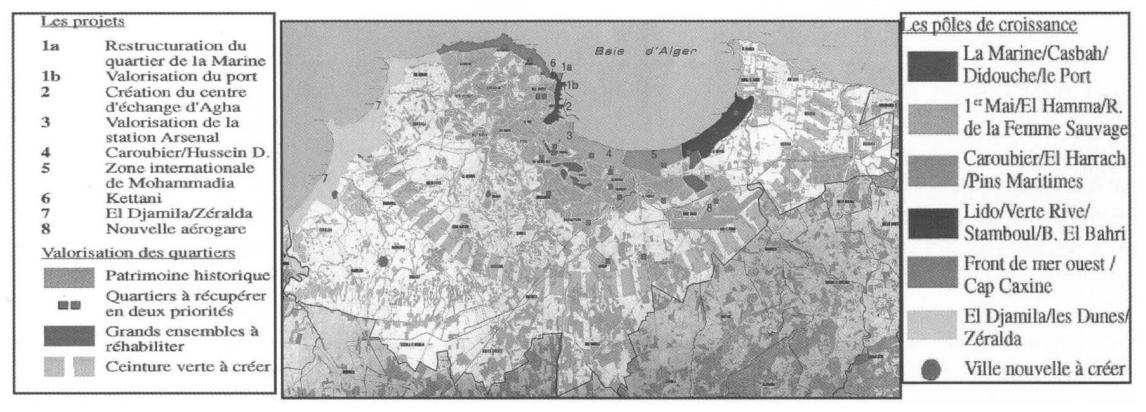
22 minute read
Continued Gentrification o f Existing Cityscapes in the Present Day
Discussions on Orientalism, Occidentalism and colonialism are not discussed often in modern-day practice of architecture; however, their importance is still vital in the way power relations and struggles have developed in the 21st Century. Contemporary ideas of Orientalism have expanded beyond the traditional representations of exoticism as first presented by European travellers in the 19th Century. Greatly influenced by the media, Orientalism is still prevalent in an ongoing system of domination of the "other" It is now a mainstay of our current collective lexicon, a ubiquitous piece of exotic othering and imperialism and a newfound tool for subjugation in the 21st Century
In the present day, these postcolonial and idealistic orientalist cities take form in urban design through ideas of globalization and newly developed ideas of racial capitalism and whiteness, which has been described as "the ownership of the Earth forever and ever" 83 by WEB. Du Bois Racial capitalism was a term first coined by Cedric Robinson in the year 2000, in which he attempted to redefine the dynamics of the contemporary world where he argued that all forms of capitalism are racial in their origins. In his 2021 journal article, David Wearing notes how these ideas of racial capitalism have been built on the concept of Orientalism, where certain middle eastern cultures have been racialized within western discourse to justify the development of an unjust global capitalist system. 84
Advertisement
It is essential here to link ideas of racial capitalism and modern-day economics as forming as a result of the colonial period and postcolonial imperialism. These set the basis of socially constructed colonial racial ideologies and their structures that continue to exist in the modern-day and relate directly to the role that race plays in the development of the inequities of capitalism.
Since the late 20th C entury, and with the rise of the digital age, capitalism has been working hand in hand with ideas of globalization and neoliberalism. 85 New neoliberal urban regeneration projects are being developed as new districts across various Arab capitals. These new districts, developed in close proximity to and in the further gentrification of the local downtown areas, cater to a new global lifestyle that encourages excessive consumption through retail and real estate to attract occident financial providers. 86
Globalization in the scope of this study is understood as part of the continuing history of imperialism through capitalist and postmodern development and expansion. With globalization and the rise of the digital age, two questions seem to arise, one being the question of how and if globalization is further promoting empirical agendas and the other being: is globalization eroding the ideas of a postcolonial world? In Said's 1995 essay "Orientalism: an Afterword", he defines globalization as "a system by which a small financial elite expanded its power over the whole globe,
83 Andrew Baldwin and Bruce Erickson, "Introduction: Whiteness, Coloniality, And The Anthropocene", Environment And Planning D: Society And Space, 38.1 (2020), 3-11 <https://doi.org/10.1177/0263775820904485>.
84 David Wearing, "The Myth Of The Reforming Monarch: Orientalism, Racial Capitalism, And UK Support For The Arab Gulf Monarchies", Politics, 2021, 026339572110415 <https://doi.org/10.1177/02633957211041547>.
85 Neoliberalism here is defined as “a policy model that encompasses both politics and economics and seeks to transfer the control of economic factors from the public sector to the private sector”
86 Daher, Rami Farouk. 2014. "Neoliberal urban transformations in the arab city", Environnement urbain, 7: 99115 <http://dx.doi.org/10.7202/1027729ar> inflating commodity and service prices, redistributing wealth from lower-income sectors (usually in the non-Western world) to the higher-income ones " 87
Through this, it can be argued that globalization was developed with strong hints of colonialism and Orientalism in its definition, whereby "a small financial elite" is often used to refer to developed western nations in Europe and North America that have grown to be able to project their powers at a global scale and shape the development of the rest of the world.
In a talk presented by Jacques Derrida, an Algerian-born French philosopher, in 1994, he warned that globalization is "geopolitically linked to a hyper-imperialist appropriation [that] has been underway for centuries. It imposes itself in a particularly palpable manner within the conceptual apparatus of international law and of global political rhetoric." 88
Globalization in an urban context came to manifest itself both physically, in its desire to develop more connections and links between various urban realms on a larger, more global scale, and empirically, with the rise of international architectural styles that did not seem to represent one single nation.
Moreover, with globalization, cities previously discussed, Algiers, Cairo and Baghdad, as well as others in the region, seem to be advertising and pushing towards new gentrification with designs showcasing the intent to make their cities appear more like "the hip neighbourhoods of the west" 89. While this is currently succeeding in bringing tourism into these older and more traditional quarters and enhancing creativity in the region, it is also leading to a rise in the land and property prices, forcing local and smaller shop-owners and developments to move to further out locations, furthering the social inequities in these urban centres. On a broader scale, urbanism here has developed into a form that other-ises local inhabitants in favour of intangible logistical developments that help grow a global marketplace. 90 In her 2016 publication, "Extrastatecraft: The Power of Infrastructure Space", Keller Easterling discusses the infrastructures of these global cities and argues that they have been designed in accordance with a formula that predicts our use of everyday spaces (such as parking lots, airport lounges, shopping malls, offices, and resorts). As Easterling stated, buildings are no longer individual crafted spaces; they are a series of repeatable urban arrangements in a new global world. Thus, this begins to mirror the colonial developments of the early 19th Century described in Chapter 2 Here we are reminded of Edward Said's claim that no one is entirely free from the struggle over space regardless of the context.
As a prerequisite to globalization, the late 20th and early 21st centuries also saw a rise in consumerism in the region. When examining the modern-day Arab city that has started its urban development in the late-20th C entury from a socio- economic viewpoint, anthropologist Lila Abu Lughod described those cities as operating as solely sites of consumption that lack production 91 , which references a foreign discouragement of local independence and creates a distinction between the operational mechanisms of The Occident City as previously described by Max Weber in Chapter 2, to be a city with the availability of a market, a court of law, and political autonomy.
87 Victor Li, "Globalorientalization: Globalization Through The Lens Of Edward Said's Orientalism", 2020 <https://go.gale.com/ps/i.do?id=GALE%7CA613049752&sid=googleScholar&v=2.1&it=r&linkaccess=abs&i ssn=00041327&p=LitRC&sw=w&userGroupName=anon%7E8ec70403> [Accessed 22 June 2022].
88 Ibid.
89 "Gentrification Is A Late Comer To Dubai", Ft.Com <https://www.ft.com/content/46eae09e-83e9-11e58e80-1574112844fd> [Accessed 31 March 2022].
90 Keller Easterling, Extrastatecraft : The Power Of Infrastructure Space, 2011.
91 Abu-Lughod J (1984) Culture, modes of production and the changing nature of cities in the Arab world. In: Agnew J, Mercer J and Sopher D (eds) The City in Cultural Context. Boston, MA: George Allen and Unwin, pp. 94–119
Al Mounajim
This, along with Weber's perspective on the differences between occidental and oriental civilizations in the development of a capitalist economy, as described in Chapter 3, led Max Weber to develop the belief that Oriental states are incapable of capitalist development. Thus, the failure of Middle Eastern cities following the colonial era in the mid-20th Century was often blamed, as Daniel Lerner stated, on the beliefs of the individuals, instead of their histories.
Following the development of capitalism in the global city, cities around the globe began to adopt a "cyber city" persona. A cyber city here is defined as a "city with a strong basis in information technology " 92
In "How not to be seen – a fucking didactic educational movie", the politics of other and visibility are examined in this new world of the cyber city. Here, othering is continually seen as a form of elimination, liquidation, or dissimilation, wherein the history of "the others" is unseen and ignored. 93 Similarly, a range of new developments are currently arising throughout the region with little to no regard for the current needs of its residents.
This lack of human-centric design results in the deepening of the urban segregation orientalist crisis of the dual cities: a capitalism crisis developing into neo-feudalism Neo-feudalism has emerged in the past decade to describe tendencies associated with severe inequalities within a city. While these developments do provide for fast growth of the global market, it is vital that they are developed alongside the more mundane traditional quarters of a city rather than on top of them.
Urbanization and globalization in most Middle Eastern cities continued to grow exponentially in the early 21st Century as a result of internal migrations of people seeking better livelihoods in urban centres and those escaping conflicts 94
Cities such as Dubai have seen remarkable growth in the last decade alone. The urban scene of Dubai quickly grew from a small traditional fishing village into a city filled with privately-owned shopping malls and housing communities as a result of an influx of capital following the discovery of oil in the region 95 and the rise of its prices in the late 20th Century This new wealth led to constant development in Dubai, which in turn led to the gentrification of older, more traditional neighbourhoods in Dubai in an effort to allow "gallery owners, cafes, architectural practices, and designers" to set up shop to make Dubai "appear more hip". 96
Following the development of Dubai in a short time frame, various other Arab cities are now looking at following in its footsteps in a process being called "Dubaificiation" or "Dubaization" Dubaification here means the complete gentrification of cities to become major urban realms and nodes for the flow of people and global capital.
Following political turmoil and instability caused by a variety of factors at the start of the 21st Century, Algiers, Cairo, and Baghdad are all currently cities in need of revitalization in their development and desire to become global cities.
92 "Cybercity", Wordsense Dictionary <https://www.wordsense.eu/cybercities/> [Accessed 23 June 2022].
93 Hito Steyerl, How Not To Be Seen – A Fucking Didactic Educational Movie, 2013.
94 Nasser Yassin, "Urbanization In The Arab World: Between “Dubaification” & “Campification”", 2016 <https://www.syndicateofhospitals.org.lb/Content/uploads/SyndicateMagazinePdfs/2963_22-23.pdf> [Accessed 22 June 2022].
95 "How Did Dubai Become Rich?", 2020 <https://www.ictsd.org/business/rich/how-did-dubai-become-rich/> [Accessed 22 June 2022].
96 Rashid bin Shabib and Ahmed bin Shabib, "Gentrification Is A Late Comer To Dubai", Ft.Com, 2015 <https://www.ft.com/content/46eae09e-83e9-11e5-8e80-1574112844fd> [Accessed 22 June 2022].
The mid-2010s saw the rise of developments in all three cities. This includes the launch of the Big Urban Project (BUP) by the Governorate of Greater Algiers in 2006 for the redevelopment of the coastline of Algiers, which aimed to regenerate the buildings of the Casbah. Challenges here arose due to the attainment of funds to develop this, administrative questions regarding the development of privatized properties from the postcolonial era, and a "lack of political will". 97
A plan was also set up in 2016, with the Algerian government announcing their selection of "starchitect" Jean Nouvel to revitalize the Casbah of Algiers. Soon after this announcement, however, Leopold Lambert, along with two anonymous writers, released an article in The Funambulist 98 arguing that "the Casbah's residents should be in control of its fate: French colonization had already caused enough damage to the district, and Nouvel should not accept a commission that might lead to its tourist development and gentrification" 99 . This article brought to light the remaining notions of colonial supremacy and class-based power struggles that the Algerian authorities still held on to and led to the eruption of a non-violent revolution against gentrification in February of 2016.
Following the postcolonial period of the 20th Century, Baghdad was faced with a new colonial era at the start of the 21st C entury, where the city's traditional quarters were utilized for military operations until the early 2010s. Following this period, similar restoration projects were proposed to occur in Baghdad.
While Dubaification was growing in popularity, Algeria, Egypt and Iraq did not have the funds to sustain the development of existing quarters at the scale and speed upon which Dubai seemed to do. Thus, they began expanding outside city limits to achieve these prospects.
97 Stephen Zacks and others, "Cultural Capital: The Ongoing Regeneration Of Algiers' Casbah - Architectural Review", Architectural Review, 2022 <https://www.architectural-review.com/essays/cultural-capital-theongoing-regeneration-of-algiers-casbah> [Accessed 22 June 2022].
98 "About The So-Called “Revitalization” Of Algiers’ Casbah: An Open Letter To Jean Nouvel", The Funambulist Magazine, 2018 <https://thefunambulist.net/editorials/called-revitalization-algiers-casbah-open-letter-jeannouvel> [Accessed 19 June 2022].
99 Stephen Zacks and others, "Cultural Capital: The Ongoing Regeneration Of Algiers' Casbah - Architectural Review", Architectural Review, 2022 <https://www.architectural-review.com/essays/cultural-capital-theongoing-regeneration-of-algiers-casbah> [Accessed 22 June 2022].
Tabula Rasa Urban Developments
Taking in the lessons learnt from the drawbacks of the "Dubaification" process, and alternatively to developing oriental cities and building over existing structures and communities (as has been the norm since colonial times), images of new urban developments are arising in the region that exist on a tabula rasa and develop alongside rising cyberculture around the globe These include developments such as NEOM, Amaala, and Masdar City.
NEOM is set to the first wholly new and artificial neo-liberal city. Located in the Northwest of Saudi Arabia, the city is expected to be the size of Belgium by 2030 100 . It is set to become a vision of what the future could be, with close ties to the Suez Canal allowing for global market access Phonetically, the word NEOM is made up of two words, "Neo", the Greek prefix meaning new and the abbreviation of the word mustaqbal, which means "the future" in Arabic
When choosing a location for this new city, it was imperative that the new site would be on a large area of vacant land, where everything in the city is meant to "start from scratch" 101 to avoid repeating failures of conventional city design, incorporating new technologies and artificial intelligence.
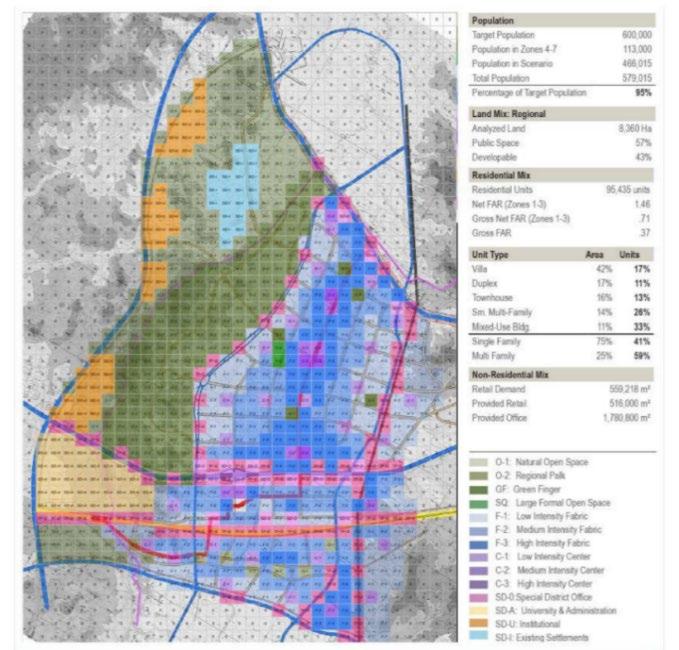
The architecture of NEOM is set to oppose more international design styles found in cities such as Dubai, New York, and Singapore. It does not aim to be the next generic city. Rather, it will focus on a sustainable development plan built on pre-colonial ideas of vernacular architecture through its landscaping, streetscape, public space and building heights.
100 Merlyn Thomas and Vibeke Venema, "Neom: What's The Green Truth Behind A Planned Eco-City In The Saudi Desert?", BBC News, 2022 <https://www.bbc.co.uk/news/blogs-trending-59601335> [Accessed 26 March 2022].
101 "NEOM | What Does NEOM Mean?", Cyberdefinitions.Com, 2022 <https://www.cyberdefinitions.com/definitions/NEOM.html> [Accessed 23 June 2022].
102 Khaled Fallatah, "Guide For Sustainable Design Of NEOM City" (Master of Architecture, Rochester Institute of Technology, 2019).
Moreover, NEOM provides an unprecedented scale for uniting urban design with cyberspace, utilizing new digital technologies to develop a new vernacular and minimize the globalized linear economy trend of exhaustive energy use and resource depletion into a more circular one based around cyberculture and design 103
Social anthropologists such as Arturo Escobar offer a broader concept of this cyberculture. In his essay "Welcome to Cyberia: A Note on Cyberculture Anthropology," Escobar positioned cyberculture as a study of the spatial restructuring that helps develop and is developed by new technologies. 104 With the advent of internet technology, he marks specific breakpoints in anthropological practice with the belief that all technologies are cultural inventions in the sense that technology creates the world. They arise from specific cultural conditions and contribute to the creation of new social and cultural situations that create a system of technological societies. NEOM combines these "smart" technologies with traditional design to develop a green city.
It utilizes simulation programmes such as Interactive Regional Planning (IRP) 105 that facilitate regional planning scenarios and provides real-time feedback in analysing various metrics influencing planning decisions. This programme is based on pattern-based metrics that help predict a building's performance in multiple contexts, often recommending regional oriental and traditional architecture as opposed to more international globalized architectural trends.
Similar to the traditional design of old quarters, a computerized design of narrow streets will protect pedestrians from harsh sunlight while also creating cross ventilation and developing new public realms for walkability and socialization 106. High-density levels will also be used to provide a mixture of commercial, retail, and residential units to shorten travel distance. Finally, modes of modern thermal systems will be abandoned in favour of passive ones through vernacular wind catchers, courtyard, and stack roof ventilation. 107
All these sustainable design measures link back to ancient design in a way that helps stakeholders rediscover their heritage, as architects such as Hassan Fathy first aimed to achieve in the 20th century
NEOM will also include aspects of design that, through technical simulations, link back to the oriental city's desires for a private space away from onlookers on the street, similar to the design of the pre-colonial Casbah in Algiers. This will be done through reintroducing the ancient mashrabiyyeh, allowing both privacy and natural ventilation in interior spaces.
In addition to utilizing new technologies that are bridging the gap between present-day design and vernacular architecture of the past developed by years of colonization and industrialization, NEOM will also use cyberspace to create a "new model of extraordinary livelihoods through exciting technologies that will bridge the gap between the man and the machine" 108 linking the present to future developments in the digital age.
103 Ibid.
104 Arturo Escobar and others, "Welcome To Cyberia: Notes On The Anthropology Of Cyberculture", Current Anthropology, 35 (1994), 211-231 <https://www.jstor.org/stable/2744194> [Accessed 31 March 2022].
105 Khaled Fallatah, "Guide For Sustainable Design Of NEOM City" (Master of Architecture, Rochester Institute of Technology, 2019).
106 Ibid.
107 Ibid.
108 Fatah al-Rahmah Youssef, "Neom, A New Model For Extraordinary Living", Asharq Al-Awsat, 2020 <https://english.aawsat.com//home/article/2142871/neom-new-model-extraordinary-living> [Accessed 22 June 2022].
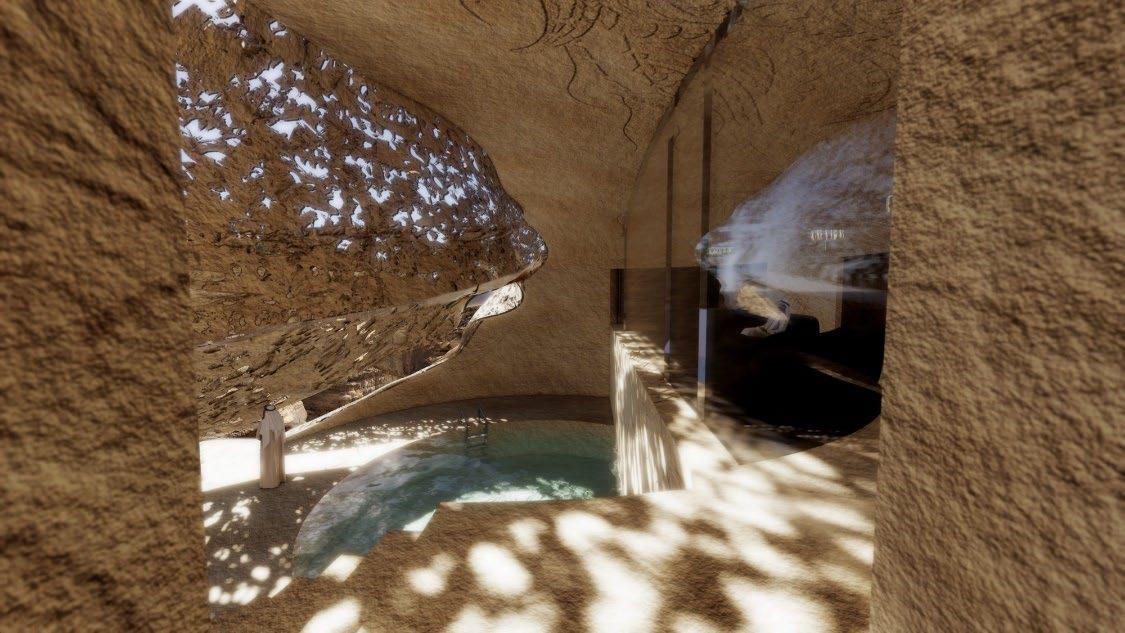
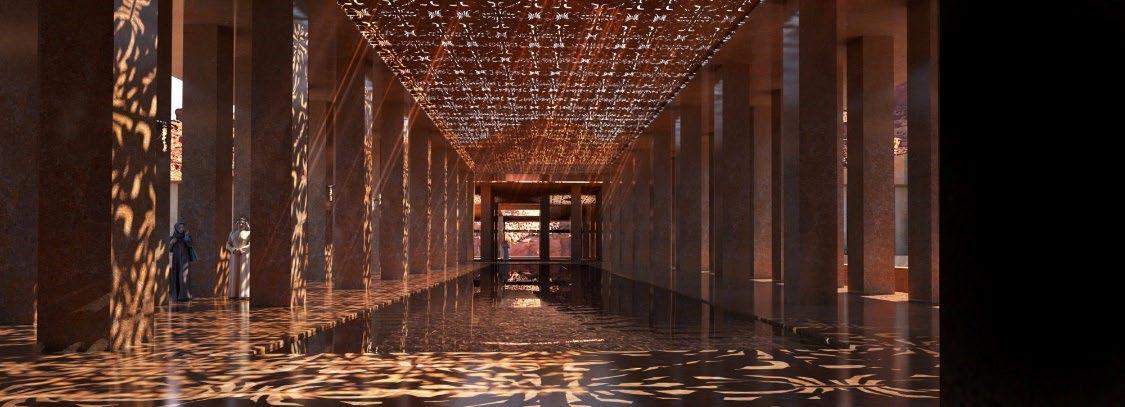
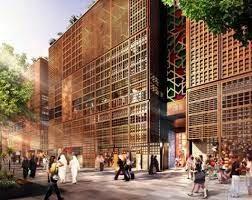
While not as cyber-culture-focused, similar plans are being hailed for new developments in Cairo and Baghdad that utilize new simulation-based technologies. In Cairo, a neighbouring city named "New Cairo" is proposed 109. An estimated 5 million people will be reside here alongside 663 hospitals and clinics, 1,250 mosques and churches and a theme park 110 This town is set to exist on an empty land just outside the current limits of the city of Cairo. Similarly to NEOM, it has been built with local techniques reintroduced by Hassan Fathy in mind.
Despite continued colonial intervention in Iraq, developments in Baghdad have also been proposed on a tabula rasa on the city's outskirts. Al-Rafeel City was proposed for the construction of an estimated 75,000 homes for roughly 300,000 people, various retail and commercial spaces, as well as hospitals and schools 111
In criticality of these new neo-liberal cities and the current socio-political context, it becomes vital that cities such as NEOM, New Cairo and Al Rafeel City develop a better understanding of the client and users who will be utilizing these spaces in an effort to counter-act rising threats of neofeudalism. Ten years following the start of construction, New Cairo is only home to a few hundred thousand people The reason behind this is the development of this city as a space that will only
109 Patrick Kingsley, "A New New Cairo: Egypt Plans £30Bn Purpose-Built Capital In Desert", The Guardian, 2015 <https://www.theguardian.com/cities/2015/mar/16/new-cairo-egypt-plans-capital-city-desert> [Accessed 22 March 2022].
110 Ibid.
111 Tim Gibson, "Iraq Is Set to Build A New Capital City On The Outskirts Of Baghdad", The B1M, 2021 <https://www.theb1m.com/article/iraq-is-set-to-build-a-new-capital-city-on-the-outskirts-of-baghdad> [Accessed 22 June 2022].
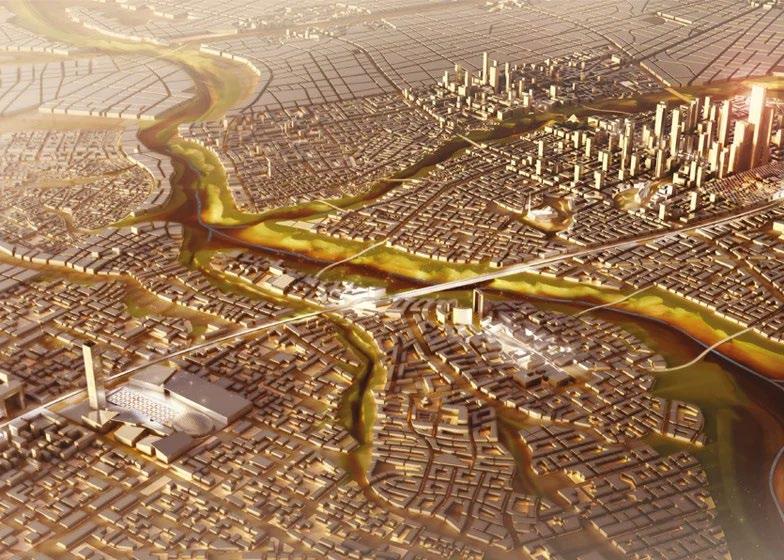
Al Mounajim
facilitate further social divide. While it is still in its early stages, New Cairo has failed to provide jobs for all skill levels in Cairo and failed to facilitate transport to the poorer communities in Cairo. 112 Thus, while there is a demand for people to live there, this demand is halted due to the inability of this new district to provide a sustainable and affordable home for all; its intentions seem to be driven by developers keen to create spaces of "prestige". It is thus vital that, with the further development of this city and the establishment of Al Rafeel City, and NEOM, which have promised over 100,000 113 and 250,000 114 jobs, respectively, this issue will be addressed
Moreover, with the rise of these new cities, a critical discussion into an architecture free of notions of postcolonialism is presented. Is the architecture of NEOM postcolonial, as all case studies explored before it, or does it become one of the first presented forms of post-colonial architecture?
NEOM presents an interestingly unique case in which this new free- floating global capital, which operates beyond the realms of colonial or regional control 115, becomes a seemingly de-historicised city, unaffected by any version of its past, colonised or not, as it lies on an untouched land. Unaffected by the landscape and cityscape around it, it is able to utilise simulation technologies to redefine the local vernacular and international styles of architecture in a way which is entirely selfserving in response to its context and functionality. This, at its very core, contradicts the definition of postcolonialism presented at the start of this dissertation. Whether this endeavour of digital cities that are completely post-colonial is possible raises an interesting line of discussion.
While, with the onset of digital cities, ideas of postcolonialism are being abandoned in favour of precolonial architectural forms and ideals, NEOM presents an architecture this is not linked to colonialism in the 19th and 20th centuries. However, with the development of global forces of neofeudalism comes a new risk of colonialism, as argued by Mouton and Burns, being referred to an “digital or neo-colonialism”. 116 These digital cities face the risk of creating new “premium networked spaces that are customized precisely to the needs of powerful users and spaces, whilst bypassing less powerful users and spaces” 117 along with imperial methods of data control and processing risks in digital cities.
112 Patrick Kingsley, "A New New Cairo: Egypt Plans £30Bn Purpose-Built Capital In Desert", The Guardian, 2015 <https://www.theguardian.com/cities/2015/mar/16/new-cairo-egypt-plans-capital-city-desert> [Accessed 22 March 2022].
113 Tim Gibson, "Iraq Is Set To Build A New Capital City On The Outskirts Of Baghdad", The B1M, 2021 <https://www.theb1m.com/article/iraq-is-set-to-build-a-new-capital-city-on-the-outskirts-of-baghdad> [Accessed 22 June 2022].
114 Fatah al-Rahmah Youssef, "Neom, A New Model For Extraordinary Living", Asharq Al-Awsat, 2020 <https://english.aawsat.com//home/article/2142871/neom-new-model-extraordinary-living> [Accessed 22 June 2022].
115 Giorgio Cafiero and Theodore Karasik, "Saudi Arabia's Futuristic Ambitions", Fair Observer, 2017 <https://www.fairobserver.com/region/middle_east_north_africa/neom-saudi-arabia-economy-middleeast-gulf-news-16251/> [Accessed 23 June 2022].
116 Morgan Mouton and Ryan Burns, "(Digital) Neo-Colonialism In The Smart City", Regional Studies, 55.12 (2021), 1890-1901 <https://doi.org/10.1080/00343404.2021.1915974>.
117 Ayona Datta, "The Digital Turn In Postcolonial Urbanism: Smart Citizenship In The Making Of India's 100 Smart Cities", Transactions Of The Institute Of British Geographers, 43.3 (2018), 405-419 <https://doi.org/10.1111/tran.12225>.
Chapter 6 – A New Manifesto for Design
Mounajim
54% of the current Middle Eastern population resides in urban centres. With vast economic and regional expansions, this figure is expected to be 75% by 2050. 118 While the Charter of Athens was not viable for the urban design of oriental cities, causing severe segregation issues in the 20th Century, it became even less feasible with the challenges of climate change, cultural appropriation, and, most recently, globalization.
In this digital age, boundaries and cultural identities are becoming increasingly blurred and interactive beneath a web of cities and information transfer developing through foreign technologies, investments, and rapid population growth. These developments have brought economic growth models that beget a cultural evolution through rediscovery of vernacular civilizations. Culture and architectural heritage, here, become a guide to how one can interpret their identity through a mountain of information. As a symbol of inhabitable space, architecture is thus unrefutably a vessel for the manifestation of these contemporary ideals in the 21st Century. Over time, and with different expressions, it becomes a negotiation into the cultural consciousness of a city.
Thus, based on these developments and the uncertainty the future pertains to, a new manifesto should be developed for urban planning in the 21st Century Middle East. Built on ideas explored in Chapters 2, 3 and 4, this manifesto concludes this dissertation and aims to present itself as a guide to more sustainable and respectful urban design that avoids urban confinement and segregation through architecture that reflects multi-culturist ideals in developing an individual's identity and expression of self It will closely study the Athens Charter and use it for inspiration in its language It will aim to utilize language that allows for constant development of urban realms in this new globalized stage where city dwellers are constantly surrounded by information and aspirations. It will also move away from early orientalist ideas that have postulated a body of ideas, beliefs and cliches that have been regarded as truths for so long. 119 Instead, it will help bring light to notions of absurdity, fanaticism and degeneracy that come with imperial texts written through a colonial lens in the present day.
The vast aim for this manifesto will thus be the development of a transformative guide built in the confines of the cyber- development age that can push communities to re-perceive the architectural achievements of their past (pre-colonial, colonial, or postcolonial) and utilize it to assimilate a new architecture of the future as the local culture of a region can be rediscovered while a global culture can be created. This thus presents the core at which people can look to develop new spatial reconstructions of their cities
118 Amal Dababseh, "Urban Areas In The Arab Region: Time For Adaptation To Climate Change", 2012 <https://www.boell.de/en/2012/11/21/urban-areas-arab-region-time-adaption-climate-change> [Accessed 31 March 2022].
119 Edward Said, 1978. Orientalism
Figure 23. This manifesto (made to look like an incomplete work-in-progress to signify the need for constant adaptation) presents a guide on which cities are proposed to be developed in an adaptive and transformative postcolonial region. It forms a basis that can be adapted as contexts and digital development arise. It aims to conclude this dissertation and encourages further exploration into ideas of orientalism and its associated colonial and postcolonial pasts in the development of a non-neo-feudalist digital cyber-city.
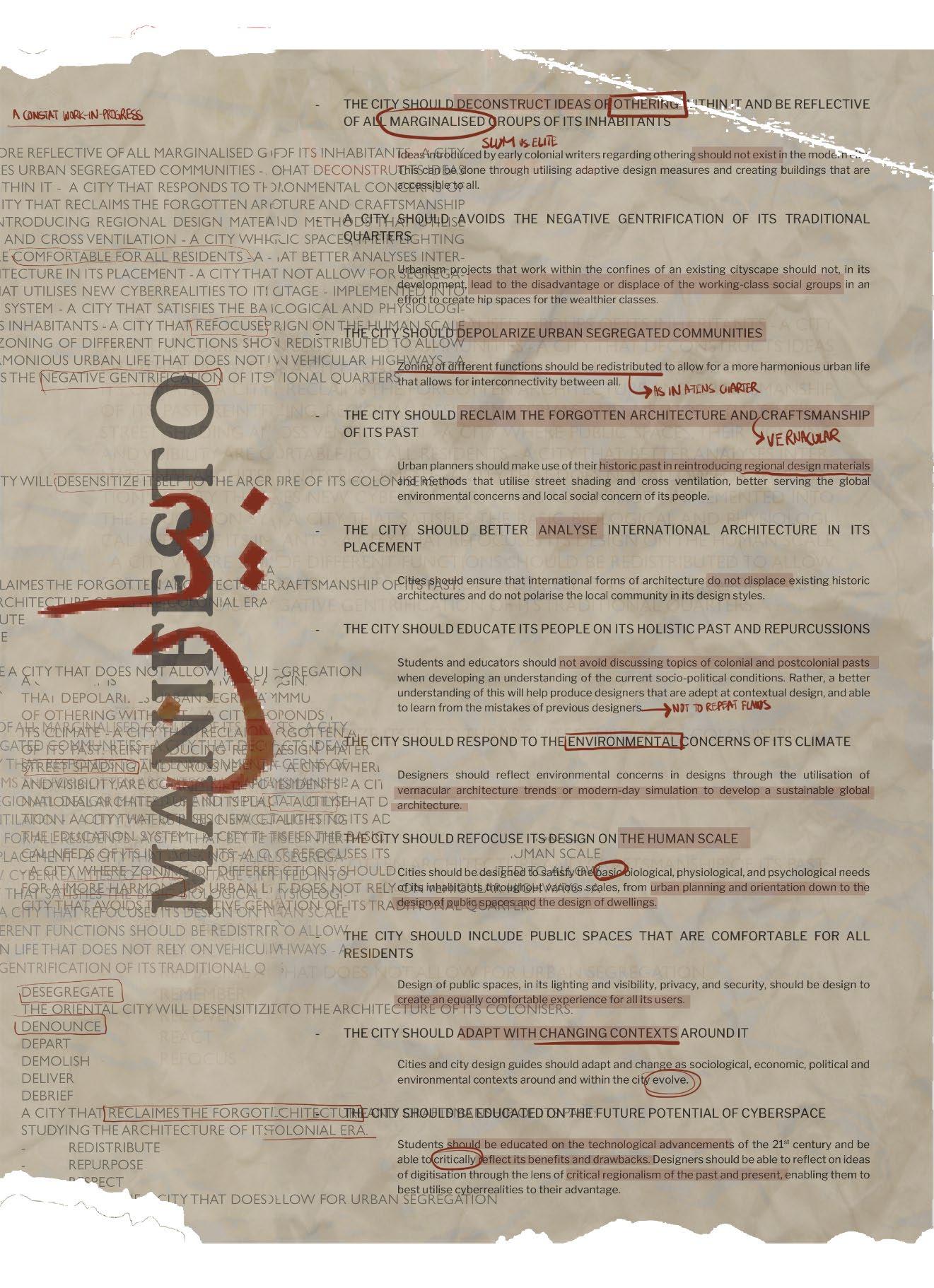
Daniah Al Mounajim Orientalism and Postcolonialism in the MA Architecture Design and Development of Arab Cities
Bibliography
"About The So-Called "Revitalization" Of Algiers' Casbah: An Open Letter To Jean Nouvel", The Funambulist Magazine, 2018 <https://thefunambulist.net/editorials/called-revitalization-algierscasbah-open-letter-jean-nouvel> [Accessed June 19th 2022]
Abu-Lughod J (1984) Culture, modes of production and the changing nature of cities in the Arab world. In: Agnew J, Mercer J and Sopher D (eds) The City in Cultural Context. Boston, MA: George Allen and Unwin, pp. 94–119
Ackley, Brian, "Le Corbusier's Algerian Fantasy: Blocking The Casbah | Bidoun", Bidoun, 2022 <https://www.bidoun.org/articles/le-corbusier-s-algerian-fantasy> [Accessed March 31st 2022]
Akcan, Esra, "A Translation Movement", Cca.Qc.Ca <https://www.cca.qc.ca/en/articles/83798/atranslation-movement> [Accessed June 22nd 2022]
Ali, Erum, "Us and Them "
"Algeria - The Algerian War Of Independence", Encyclopedia Britannica, 2022 <https://www.britannica.com/place/Algeria/The- Algerian-War-of-Independence> [Accessed 23 June 2022]
AlSayyad, Nezar, Forms Of Dominance On The Architecture And Urbanism Of The Colonial Enterprise (Aldershot: Avebury, 1992)
Angotti, Thomas, The New Century Of The Metropolis (New York: Routledge, 2013)
"Baghdad Gymnasium", Archnet.Org, 2022
<https://www.archnet.org/sites/345> [Accessed June 22nd 2022]
Bahoora, Haytham, "Modernism On The Margins: Le Corbusier's Baghdad Gymnasium And The Politics Of Discovery, Forthcoming, Aesthetic Practices And Spatial Descriptions: Configurations Of Micro, Macro, Meso," (University of Toronto)
Baldensperger, "Ou. s'affrontent I'Orienl el I'Occident intellectuels," in studcs d'histoire litthaire, 3rd seL (Paris; Droz, 1939). p. 230
Baldwin, Andrew, and Bruce Erickson, "Introduction: Whiteness, Coloniality, And The Anthropocene", Environment And Planning D: Society And Space, 38 (2020), 3-11 https://doi.org/10.1177/0263775820904485
Bernad, Martina, "Colonialism And Architecture – Postcolonial Studies", Scholarblogs.Emory.Edu, 1998 <https://scholarblogs.emory.edu/postcolonialstudies/2014/06/20/colonialism-andarchitecture/> [Accessed June 22nd 2022]
Bilsel, Cana, " 'Le Corbusier In Turkey: From The Voyage D'Orient To The Master Plan Proposal For Izmir On The Theme Of A Green City", A Swiss In The Mediterranean: Le Corbusier Symposium, Cyprus International University, Lefkoşa, 2015, 54-64 <https://www.academia.edu/34580832/Bilsel_Cana_Le_Corbusier_in_Turkey_From_the_Voyag e_d_Orient_to_the_Master_Plan_Proposal_for_Izmir_on_the_Theme_of_a_Green_City_Ay%C5 %9Fe_%C3%96zt%C3%BCrk_Atilla_Y%C3%BCcel_eds_A_Swiss_in_the_Mediterranean_Le_C
Daniah Al Mounajim Orientalism and Postcolonialism in the MA Architecture Design and Development of Arab Cities orbusier_Symposium_Cyprus_International_University_Lefko%C5%9Fa_2015_pp_54_64>
[Accessed June 22nd 2022] bin Shabib, Rashid, and Ahmed bin Shabib, "Gentrification Is A Late Comer To Dubai", Ft.Com, 2015 <https://www.ft.com/content/46eae09e-83e9 -11e5-8e80-1574112844fd> [Accessed June 22nd 2022]
Bozdogan, Sibel, "Orientalism And Architectural Culture", Social Scientist, 14 (1986), 46 <https://doi.org/10.2307/3517250>
Brain, Jessica, "Timeline Of The British Empire - Historic UK", Historic UK <https://www.historicuk.com/HistoryUK/HistoryofBritain/Timeline- Of-The-British-Empire/> [Accessed March 31st 2022]
Cafiero, Giorgio, and Theodore Karasik, "Saudi Arabia's Futuristic Ambitions", Fair Observer, 2017 <https://www.fairobserver.com/region/middle_east_north_africa/neom-saudi-arabia-economymiddle-east-gulf-news-16251/> [Accessed 23 June 2022]
Celik, Zeynep, "Le Corbusier, Orientalism, Colonialism", Assemblage, 1992, 58 https://doi.org/10.2307/3171225
Çelik, Zeynep, Urban Forms And Colonial Confrontations (Berkeley: University of California Press, 1997)
Current Affairs, "The Need For A New Garden City Movement "Current Affairs", Current Affairs, 2022 <https://www.currentaffairs.org/2021/07/the-need-for-a-new-garden-city-movement>
[Accessed March 24th 2022]
"Cybercity", Wordsense Dictionary <https://www.wordsense.eu/cybercities/> [Accessed 23 June 2022]
Dababseh, Amal, "Urban Areas In The Arab Region: Time For Adaptation To Climate Change", 2012 <https://www.boell.de/en/2012/11/21/urban-areas-arab-region-time-adaption-climatechange> [Accessed March 31st 2022]
Daher, Rami Farouk. 2014. "Neoliberal urban transformations in the arab city", Environnement urbain, 7: 99-115 http://dx.doi.org/10.7202/1027729ar
Damluji, Salma Samar, and Viola Bertini, Hassan Fathy: Earth And Utopia (London: Laurence King, 2018)
Datta, Ayona, "The Digital Turn In Postcolonial Urbanism: Smart Citizenship In The Making Of India's 100 Smart Cities", Transactions Of The Institute Of British Geographers, 43 (2018), 405419 <https://doi.org/10.1111/tran.12225>
Easterling, Keller, Extrastatecraft : The Power Of Infrastructure Space, 2011
"Egypt - World War I And Independence", Encyclopedia Britannica <https://www.britannica.com/place/Egypt/World-War-I-and-independence>
[Accessed 23 June 2022].
Elsheshtawy, Yasser, Planning Middle Eastern Cities (London: Routledge, 2010)
Daniah Al Mounajim Orientalism and Postcolonialism in the MA Architecture Design and Development of Arab Cities
Escobar, Arturo, David Hess, Isabel Licha, Will Sibley, Marilyn Strathern, and Judith Sutz, "Welcome To Cyberia: Notes On The Anthropology Of Cyberculture", Current Anthropology, 35 (1994), 211-231 <https://www.jstor.org/stable/2744194> [Accessed March 31st 2022]
Fabbri, Roberto, and Sultan Sooud Al-Qassemi, "Urban Modernity In The Contemporary Gulf", 2021 <https://doi.org/10.4324/9781003156529>
Fallatah, Khaled, "Guide For Sustainable Design Of NEOM City" (Master of Architecture, Rochester Institute of Technology, 2019)
Foucault, Michel, "Of Other Spaces: Utopias And Heterotopias", Architecture /Mouvement/ Continuité, 1967
"Foundations Of Western Civilization: Greece | Scholarly Sojourns", Scholarlysojourns.Com <http://www.scholarlysojourns.com/all-sojourns/foundationsof-western-civilization-greece/sojourn-overview-2/> [Accessed 23 June 2022]
"Gentrification Is A Late Comer To Dubai", Ft.Com <https://www.ft.com/content/46eae09e83e9-11e5-8e80-1574112844fd> [Accessed March 31st 2022]
Gibson, Tim, "Iraq Is Set To Build A New Capital City On The Outskirts Of Baghdad", The B1M, 2021 <https://www.theb1m.com/article/iraq-is-set-to-build-a-new-capital-city-on-the-outskirtsof-baghdad> [Accessed June 22nd 2022]
Hadjri, Karim, and M. Osmani, "Planning Middle Eastern Cities", 2004 https://doi.org/10.4324/9780203609002
"History", Royal Pavilion, 2022 <https://brightonmuseums.org.uk/royalpavilion/history/> [Accessed June 23rd 2022]
"How Did Dubai Become Rich?", 2020 <https://www.ictsd.org/business/rich/how-did-dubaibecome-rich/> [Accessed June 22nd 2022]
King, Anthony, "Exporting 'Planning': The Colonial And Neo-Colonial Experience", Urbanism Past & Present, 5 (1978), 12-22 <https://www.jstor.org/stable/44403550> [Accessed March 31st 2022]
Kingsley, Patrick, "A New New Cairo: Egypt Plans £30Bn Purpose-Built Capital In Desert", The Guardian, 2015 <https://www.theguardian.com/cities/2015/mar/16/new-cairo-egypt-planscapital-city-desert> [Accessed March 22nd 2022]
Khamis, Tariq, "The Islamic City And Architectural Orientalism", The New Arab, 2015 <https://english.alaraby.co.uk/features/islamic-city-and-architectural-orientalism> [Accessed March 31st 2022]
Le Corbusier, Jean Giraudoux, Anthony Eardley, and José Luis Sert, The Athens Charter (New York: Grossman Publishers, 1973)
Li, Victor, "Globalorientalization: Globalization Through The Lens Of Edward Said's Orientalism", 2020
<https://go.gale.com/ps/i.do?id=GALE%7CA613049752&sid=googleScholar&v=2.1&it=r&linkac
Daniah Al Mounajim Orientalism and Postcolonialism in the MA Architecture Design and Development of Arab Cities cess=abs&issn=00041327&p=LitRC&sw=w&userGroupName=anon%7E8ec70403> [Accessed June 22nd 2022]
Macmillan, Harold, "The Wind Of Change Speech" (Cape Town, South Africa, 1960)
Mourad, Mahy, "Heliopolis, Egypt: Politics Of Space In Occupied Cairo", The Funambulist, 2017 <https://thefunambulist.net/magazine/10-architecture-colonialism/heliopolis-egypt-politicsspace-occupied-cairo-mahymourad#:~:text=Divided%20into%20old%20and%20new,Imperialism%20and%20Revolution% 2C%201967).> [Accessed June 22nd 2022]
Medovarski, Andrea, "Unstable Post(‐)Colonialities: Speculations Through Punctuation", World Literature Written In English, 39 (2002), 84-100 https://doi.org/10.1080/17449850208589360
"Military Planning - Middle East - Northern Architecture", Northern Architecture, 2022 <https://www.northernarchitecture.us/middle-east/military-planning.html> [Accessed March 31st 2022]
Mignolo, Walter, Local Histories/Global Designs: Coloniality, Subaltern Knowledges, And Border Thinking (Princeton Studies In Culture/Power/History) (Princeton University Press)
Mir, Salam, "Colonialism, Postcolonialism, Globalization, And Arab Culture", Arab Studies Quarterly, 41 (2019) https://doi.org/10.13169/arabstudquar.41.1.0033
Moore, James, "Making Cairo Modern? Innovation, Urban Form And The Development Of Suburbia, C. 1880–1922", Urban History, 41 (2014), 81-104
<https://www.jstor.org/stable/26398263?seq=1> [Accessed June 22nd 2022]
Mouton, Morgan, and Ryan Burns, "(Digital) Neo-Colonialism In The Smart City", Regional Studies, 55 (2021), 1890-1901 <https://doi.org/10.1080/00343404.2021.1915974>
Naderi, Nader, "European Absolutism Vs Oriental Despotism: A Comparison And Critique", Michigan Sociological Review, 8 (1994) <https://www.jstor.org/stable/40968982>
[Accessed March 31st 2022]
Naderi, Nader, "Max Weber And The Study Of The Middle East: A Critical Analysis", Berkeley Journal Of Sociology, 35 (1990), 71-88 <https://www.jstor.org/stable/41035498?seq=1>
[Accessed June 19th 2022]
"NEOM | What Does NEOM Mean?", Cyberdefinitions.Com, 2022 <https://www.cyberdefinitions.com/definitions/NEOM.html> [Accessed 23 June 2022]
"Orientalism - New World Encyclopedia", Newworldencyclopedia.Org, 2022 <https://www.newworldencyclopedia.org/entry/Orientalism> [Accessed 20 June 2022]
Parks, Robert, "From The War Of National Liberation To Gentrification - MERIP", MERIP, 2018 <https://merip.org/2018/08/from-the-war-of-national-liberation-to-gentrification/> [Accessed 18 June 2022]
Peluffo, Electra, "The East And The West: Reciprocal Attraction", Electrapeluffo.Com <https://www.electrapeluffo.com/pdf/occidente_oriente_eng.pd f> [Accessed June 22nd 2022]

